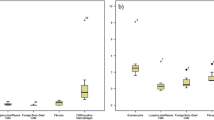Abstract
Purpose
With the link between peritoneal adhesions and infertility well established, it is critical that materials used in pelvic surgery be tested for their adhesionforming properties. The current study examined the adhesion-inducing properties of two dyes routinely used for visualization during pelvic surgery.
Design
In vivoand in vitroexamination of the effects of the dyes methylene blue and indigo carmine on adhesion formation in a mouse model.
Method
A series of three experiments was conducted. In the first, dyes were injected directly into the peritoneal cavity. The mice were then sacrificed at one of two time points and the peritoneal cavity examined for adhesion formation. In addition, because of their purposed role in adhesion formation, macrophages from the cavity were examined for signs of dye-induced activation. Further studies of macrophage activation were then conducted in vitroto determine the effects of dye concentration and exposure time on the activation process.
Results
Both methylene blue and indigo carmine appeared to induce adhesion formation as well as macrophage activation in vivo.Further, long-term exposure to visual concentrations of both dyes appeared to induce macrophage activation. However, only those macrophages exposed to methylene blue exhibited signs of activation when the exposure time was limited to times equivalent to those which might be expected during surgery.
Conclusion
Of the two dyes tested, indigo carmine might be the dye of choice in surgeries where fertility is to be maintained.
Similar content being viewed by others
References
Frantzen C, Schosser HW: Microsurgery and postinfectious tubal infertility. Fertil Steril 1982;38:397–402
Puri P, Guiney EJ, O'Donnell B, McGuinness EPJ: Effects of perforated appendicitis in girls on subsequent fertility. Br Med J 1984;288:25–26
Diamond MP, McLaughlin DS, Daniell JF, Friedman S, Feste J, Vaughn WK, Surrey MW, Martin DS: Adhesion reformation and de nonvo adhesion formation after reproductive pelvic surgery. Fertil Steril 1987;47:864–869
Trimbos-Kemper T, Trimbos B, Van Hall E: Etiological factors in tubal infertility. Fertil Steril 1982;37:384–388
Gomel V: An Odyssey through the oviduct. Fertil Steril 1983;39:144–155
Rosenburg SM, Board JA: High-molecular weight dextran in human infertility surgery. Am J Obstet Gynecol 1984;148:380–385
Meng H, Cleary RC: Sufascial dextran 70* collection after intraperitoneal instillation of hyskon. Fertil Steril 1986;46:961–962
Adhesion Study Group: Reduction of postoperative pelvic adhesions with intraperitoneal 32% dextran 70: a prospective, randomized clinical trial. Fertil Steril 1983;40:612–619
Diamond MP, Linsky CB, Cunningham T, Kamp L, Pines E, DeCherney AH, diZerega GS: Synergistic effects of INTERCEED(TC7)* and heparin in reducing adhesion formation in the rabbit uterine horn model. Fertil Steril 1991;55:389–394
McGaw T, Elkins TE, DeLancey JOL, McNeeley SG, Warren J: Assessment of intraperitoneal adhesion formation in a rat model: can a procoagulant substance prevent adhesion? Obstet Gynecol 1988;71:774–778
Diamond MP, Daniell JF, Martin DC, Feste J, Vaughn WK, McLaughlin D: Tubal patency and pelvic adhesions at early second-look laparoscopy following intraabdominal use of the carbon dioxide laser: initial report of the intraabdominal laser study group. Fertil Steril 1984;42:717–723
DeCherney AH, Mezer HC: The nature of post-tuboplasty pelvic adhesions as determined by early and late laparoscopy. Fertil Steril 1984;41:643–646
Halme J, Becker S, Hammond MG, Raj S: Pelvic macrophages in normal and infertile women: the role of patent tubes. Am J Obstet Gynecol 1982;142:890–895
Orita H, Campeau JD, Nakamura RM, diZerega GS: Modulation of fibroblast proliferation and transformation by activated macrophages during postoperative peritoneal reepithelialization. Am J Obstet Gynecol 1986;155:905–911
Goodman SB, Rein MS, Hill JA: Hysterosalpingography contrast media and chromotubation dye inhibit peritoneal lymphocyte and macrophage function in vitro: a potential mechanism for fertility enhancement. Fertil Steril 1993;59:1022–1027
Mahadevan MM, Weitzman GA, Hogan S, Breckinridge S, Miller MM: Methylene blue but not indigo carmine is toxic to human luteal cells in vitro. Reprod Tox 1993,7:631–633
Schnyder J, Baggiolini M: Induction of plasminogen activator secretion in macrophages by electrochemical stimulation of hexose monophosphate shunt with methylene blue. Proc Natl Acad Sci USA 1980;77:414–417
Author information
Authors and Affiliations
Rights and permissions
About this article
Cite this article
Prien, S.D., Dunn, C. & Messer, R.H. Adhesion-promoting properties of dyes routinely used during fertility surgeries. J Assist Reprod Genet 12, 136–140 (1995). https://doi.org/10.1007/BF02211383
Received:
Accepted:
Issue Date:
DOI: https://doi.org/10.1007/BF02211383




